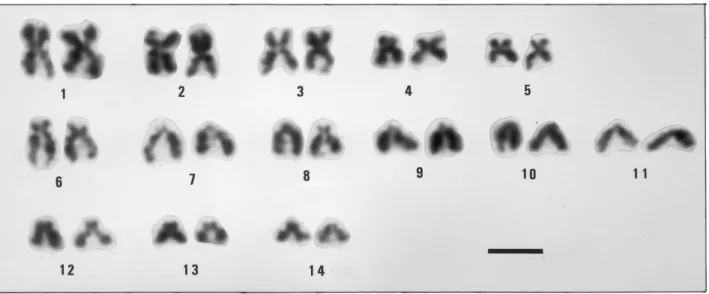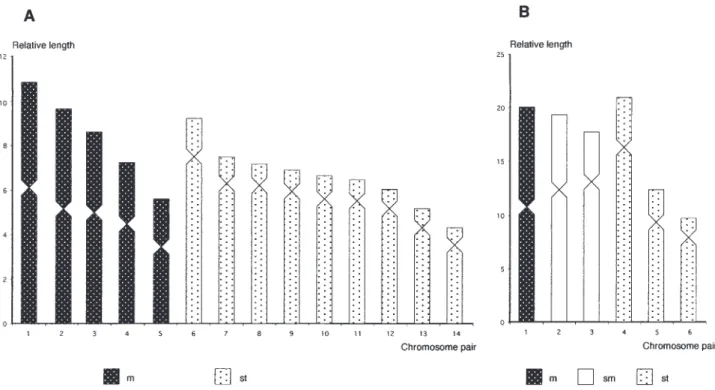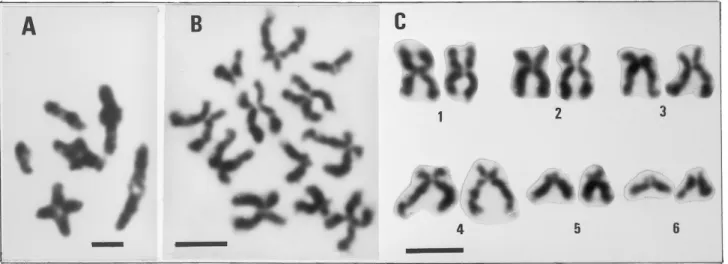HAL Id: hal-03217962
https://hal.sorbonne-universite.fr/hal-03217962
Submitted on 5 May 2021
HAL is a multi-disciplinary open access
archive for the deposit and dissemination of
sci-entific research documents, whether they are
pub-lished or not. The documents may come from
teaching and research institutions in France or
abroad, or from public or private research centers.
L’archive ouverte pluridisciplinaire HAL, est
destinée au dépôt et à la diffusion de documents
scientifiques de niveau recherche, publiés ou non,
émanant des établissements d’enseignement et de
recherche français ou étrangers, des laboratoires
publics ou privés.
KARYOTYPES OF TWO MEDITERRANEAN
BIVALVE SPECIES
C Thiriot-Quiévreux
To cite this version:
C Thiriot-Quiévreux. KARYOTYPES OF TWO MEDITERRANEAN BIVALVE SPECIES. Vie et
Milieu / Life & Environment, Observatoire Océanologique - Laboratoire Arago, 2004, pp.7-11.
�hal-03217962�
KARYOTYPES OF TWO MEDITERRANEAN BIVALVE SPECIES
C. THIRIOT-QUIÉVREUX
Observatoire Océanologique de Villefranche, UPMC – CNRS – INSU, BP 28, 06230 Villefranche-sur-Mer, France thiriot@obs-vlfr.fr BIVALVE MYTILASTER MINIMUS ANOMIA EPHIPPIUM CHROMOSOME NUMBER KARYOTYPE
ABSTRACT. – Chromosome preparations of two Mediterranean species were stu-died using an air-drying technique and conventional Giemsa staining. In Mytilaster minimus (Mytilidae), a diploid chromosome number of 28 was found in gill tissue and the karyotype included five metacentric and nine subtelocentric chromosome pairs. In Anomia ephippium (Anomiidae), chromosome numbers were n=6 in gona-dal tissue and 2n=12 in gill tissue. Its karyotype included one metacentric, two sub-metacentric and three subtelocentric chromosome pairs. Results are discussed within known bivalve chromosome data.
BIVALVE MYTILASTER MINIMUS ANOMIA EPHIPPIUM NOMBRE DE CHROMOSOMES CARYOTYPE
RÉSUMÉ. – Les préparations chromosomiques de deux espèces de Bivalves médi-terranéens ont été étudiés par une technique de suspension cellulaire et séchage à l’air et une coloration standard au Giemsa. Chez Mytilaster minimus (Mytilidae), le nombre diploïde de chromosomes est égal à 28 dans le tissu branchial et le caryo-type est composé de 5 métacentriques et de 9 paires subtélocentriques de chromoso-mes. Chez Anomia ephippium (Anomiidae), le nombre haploïde est de 6 dans le tissu gonadique et le nombre diploïde est de 12 dans le tissu branchial. Son caryo-type est composé de 1 métacentrique, 2 paires submétacentriques et de 3 subtélo-centriques de chromosomes. Les résultats sont discutés à la lumière des données connues sur les chromosomes de Bivalves.
INTRODUCTION
The area of Banyuls-sur-Mer (West Mediterra-nean, Gulf of Lion) includes many bivalve species (Mars 1965). In particular, the mytilid Mytilaster minimus (Poli, 1795) is abundant on calcareous substrates, such as sidewalk-like banks (Delamare Deboutteville & Bougis 1951). The anomiid Anomia ephippium (Linné, 1758) is a common eurybathial species from the infralittoral to the bathylittoral level (Mars 1965). Chromosome data of bivalve species have been reviewed (Patterson 1969, Nakamura 1985, Thiriot-Quiévreux 2002). This paper reports the not yet published karyotypes of these latter species.
MATERIALS AND METHODS
Specimens of Mytilaster minimus also called Brachi-dontes (Mytilaster) minimus were sampled from the si-dewalk-like banks near Banyuls. Specimens of Anomia ephippium were dredged at ca. 30 m in the Bay of Ba-nyuls.
Live animals were incubated for 12 h in a 0.005% so-lution of colchicine in sea water. Gills in Mytilaster mi-nimus, and gonads and gills in A. ephippium, were then removed by dissection and treated for 45 min in 0.9%
sodium citrate in distilled water. The material was fixed in a freshly prepared mixture of absolute alcohol and acetic acid (3:1) with three changes of 20 min each. Sli-des were made using an air-drying technique (Thiriot-Quiévreux & Ayraud 1982). Staining was performed with 4% Giemsa in phosphate buffer pH 6.8 and photo-micrograhs of suitable metaphases were taken with a Zeiss Photomicroscope II.
Karyotype formula were obtained by statistical analy-sis of chromosome measurements. Terminology relating to centromere position follows that of Levan et al. (1964). Both the arm ratio and the centromeric index are given because each espresses centromeric position and allows comparison with previous studies. When a cen-tromere position was found on the borderline between two categories, two chromosome categories were listed according to the confidence limit of the means (P=0.05).
RESULTS
Mytilaster minimus
The chromosomes of 16 metaphases taken from 6 animals were counted. The diploid chromosome number was 28. Seven well spread metaphases were analysed (Table I). The karyotype (Fig. 1) consists of 5 metacentric (m), 2 subtelocentric (st) and 7 subtelocentric-telocentric (st-t) chromosome
8 C. THIRIOT-QUIÉVREUX
Table I. – Top, chromosome measurements and classification in 7 cells of Mytilaster minimus. Below, chromosome measurements and classification in 10 cells of Anomia ephippium.
pairs. The Figure 2 shows the ideogram constructed from relative length and centromeric index values.
Anomia ephippium
The chromosomes of 25 metaphases taken from 8 animals were counted. The diploid chromosome number was 12. Sixteenth meioses with n=6 were also observed in the gonad (Fig. 3). Ten well spread metaphases were analysed (Table I). The karyotype (Fig. 3) consists of 1 m, 1 sm, 1 sm-st, 1 st-sm, 2 st.
DISCUSSION
Chromosome data of the Mytilidae family have been reported by Libertini et al. (1996) and more recently by Torreiro et al. 1999 and Vitturi et al. 2000. The diploid chromosome numbers range from 2n=22 to 32. One species of Brachidontes, B. recurvus showed 2n=30 with 15 submetacentric chromosome pairs (Diopotex-Chong et al. 1978) while Brachidontes pharaonis had 2n=28 with 6 metacentric-submetacentrics and 8 subtelocentrics (Vitturi et al. 2000) and Brachidontes rodriguezi 2n=32 with 2 metacentrics, 12 subtelocentrics and 2 telocentric-subtelocentrics (Torreiro et al. 1999).
Three species of Mytilaster were studied, i.e. Mytilaster (Brachidontes) minimus with n=15 (Rasotto et al. 1981), Mytilaster lineatus with 2n=26 and a karyotype including 6 metacentric, 4 submetacentric, 1 subtelocentric and 1 telocentric chromosome pairs, and Mytilaster solidus with 2n=28 and 5 metacentric, 3 submetacentric, 2 subtelocentric and 4 telocentric chromosome pairs (Libertini et al. 1996). The chromosome number of Mytilaster minimus, here studied (n=14), is differ-ent from the one reported (n=15) by Rasotto et al. (1981) but similar to Mytilaster solidus (Libertini et al. 1996) and to Brachidontes pharaonis (Vitturi et al. 2000). Its karyotype formula (5 m, 9 st) in-cludes more subtelocentrics than the other Mytilaster species even if several pairs are on the bordeline of subtelocentric-telocentrics. Chromo-somal rearrangements have been suggested as a source of variation at the genus level among mytilid species (Libertini et al. 1996). Further banding techniques would be necessary to analyse the role of chromosomal rearrangements which may have occurred during the evolutionary speciation process.
Among Anomiidae, Rasotto et al. (1981) re-ported haploid number of n=12 in Anomia ephippium while Ieyama & Inaba (1974) and Ieyama (1984) gave 2n=14 in gill tissue cell of Anomia chinensis with a karyotype including 3 metacentric and 4 subtelocentric chromosomes and 2n=26 in Monia umbonata. Our study showed n=6
Fig. 2. – Ideograms constructed from relative length and centromeric index values. A, Mytilaster minimus; B, Anomia ephippium.
in meioses and 2n=12 in mitoses of Anomia ephippium. This is the smallest chromosome num-ber reported among bivalve species studied up to now where the most frequent haploid chromosome number is n=19 (Thiriot-Quiévreux 2002).
Looking among close taxonomically bivalve families, the Ostreidae also showed low haploid chromosome numbers (n=10 for most of the spe-cies and n=9 in Dendostrea folium, Ieyama 1990) as the Gryphaeidae with n=9 in Pycnodonta co-chlear (Vitturi et al. 1985). The interpretation of chromosome number as an indicator of evolution-ary status must be viewed with caution and is not necessarily congruent with bivalve phylogeny based on combined morphology and DNA se-quence data (Giribet & Wheeler 2002). The Sub-class Pteriomorpha is considered monophyletic. However chromosome numbers range from n= 6 to 19 within this Subclass. Even within families of this Subclass, chromosome numbers varied which do not imply an evolutionary trend. Looking at the families studied by Giribet & Wheeler (2002) and following the same phylogenetic rank, one finds n=11 to 16 in the Mytilidae, n=14 to 19 in the Arcidae, n=13-14 in the Pteriidae, n=16 to 19 in the Limidae, n=9-10 in the Ostreidae, n=13 to 19 in the Pectinidae, and n=6-14 in the Anomiidae (ref-erences quoted in Nakamura 1985, Libertini et al. 1996, Quiévreux et al. 1991, Thiriot-Quiévreux 2002). This chromosomal variability does not infer any evolutionary trend. Gene se-quences and chromosome profiles may not have evolved in parallel fashions.
ACKNOWLEDGMENTS. – This work was carried out
du-ring the summer 1985 at the Laboratoire Arago, Ba-nyuls-sur-Mer. Thanks are due to the collaboration of J Soyer, who was the Director of the Laboratoire Arago at that time, and to P Chang for English editing.
REFERENCES
Delamare Deboutteville C, Bougis P 1951. Recherches sur le trottoir d’Algues calcaires effectuées à Banyuls pendant le stage d’été. Vie Milieu 2: 161-181. Diopotex-Chong MA, Rodriguez-Romer F,
Uribe-Alco-cer M, Laguarda-Figueras A 1978. Karyotypic cha-racters of Brachidontes recurvus Rafinesque, 1820, (Pelecypoda: Mytilidae). An Centro Cienc del Mar y Limnol, Univ Nal Auton Mexico 5: 55-58.
Giribet G, Wheeler W 2002. On bivalve phylogeny: a high level analysis of the Bivalvia (Mollusca) based on combined morphology and DNA sequence data. Invertebr Biol 121: 271-324.
Ieyama H 1984. Chromosomes of six species in three fa-milies of Pteriomorpha. Venus 43: 106-110.
Ieyama H 1990. Chromosomes of the oysters Hyatissa imbricata and Dendostrea folium (Bivalvia: Pterio-morpha). Venus 49: 63-68.
Ieyama H, Inaba A 1974. Chromosome numbers of ten species in four families of Pteriomorpha (Bivalvia). Venus 33: 129-137.
Levan A, Fredga K, Sandberg AA 1964. Nomenclature for centromere position on chromosomes. Hereditas 52: 201-220.
Libertini A, Boato A, Panozzo M, Fogato V 1996. Ka-ryotype and genome size in some species of Myti-lidae (Bivalvia, Mollusca). Kromosomo II 82: 2819-2827.
Mars P 1965. Faune marine des Pyrénées-Orientales. Vie Milieu 15 (suppl 4), 156 p.
Nakamura HK 1985. Review of molluscan cytogenetic information based on the CISMOCH-Computerized index system for Molluscan chromosomes. Bivalvia, Polyplacophora and Cephalopoda. Venus 44: 193-225.
Patterson CM 1969. Chromosomes of molluscs. Proc 2nd Sympos Mollusca. Mar Biol Ass India 2: 635-689.
10 C. THIRIOT-QUIÉVREUX
Rasotto M, Altieri D, Colombera D 1981. I cromosomi spermatocitari di 16 specie appartenenti alla classe Pelecypoda. Atti 5th Congr Soc Malac Ital: 113-127. Thiriot-Quiévreux C 2002. Review of the literature on
bivalve cytogenetics in the last ten years. Cah Biol Mar 43: 17-26.
Thiriot-Quiévreux C, Albert P, Soyer J 1991. Karyoty-pes of five subantarctic bivalve species. J Moll Stud 57: 59-70.
Thiriot-Quiévreux C, Ayraud N 1982. Les caryotypes de quelque espèces de Bivalves et de Gastéropodes ma-rins. Mar Biol 70: 165-172.
Torreiro A, Martínez-Expósito, Trucco MI, Pasantes JJ 1999. Cytogenetics in Brachidontes rodriguezi d’Orb (Bivalvia, Mytilidae). Chromosome Res 7 : 49-55. Vitturi R, Carbone P, Catalano E 1985. The
chromoso-mes of Pycnodonta cochlear (Poli) (Mollusca, Pele-cypoda). Biol Zbl 104: 177-182.
Vitturi R, Gianguzza P, Colomba MS, Riggio S 2000. Cytogenetic characterization of Brachidontes pharao-nis (Fisher P., 1870): karyotype, banding and fluores-cent in situ hybridization (FISH) (Mollusca: Bivalvia: Mytilidae). Ophelia 52: 213-220.
Reçu le 29 avril 2003; received April 29, 2003 Accepté le 16 juin 2003; accepted June 16, 2003
12
APPEL A COMMUNICATION
Environnement Identité Méditerranée – EIM 2004
Juillet 19-25, 2004 CORTE
Université de Corse
Objectifs : Ce congrès annuel est alternativement organisé à l’Université de Corse (UdC) et dans une autre université de la Méditerranée. C’est un espace privilégié de rencontres et d’échanges entre les chercheurs travaillant sur les thèmes de l’Environnement et de l’Identité. Placé sous l’égide de l’Institut de l’Environnement (IE), ce congrès est structuré autour de 5 workshops pluridisciplinaires et transversaux
Quelles gestion et valorisation pour les patrimoines naturels en Méditerranée ?
Feux de Forêt : Modélisation, Simulation, Météorologie, Aspects humains, Biomasse
Resp. : J.H. Balbi
Gestion de l’eau : Caractérisation physico-chimique, Caractérisation biologique, Eaux de surface, Eaux souterraines Socio-économie, Patrimoine et valorisation Resp. : B. Marchand
Ressources Naturelles : Agroressources, Ressources agri-environnementales, Produits naturels, Biodiversité, Gestion des espaces naturels
Resp. : A. Bighelli
Quelles politiques de valorisation pour les patrimoines culturels en Méditerranée ?
Développement durable : Territoires, Environnement, Recyclage, Tourisme
Resp. : D. Prunetti
Patrimoines culturels : Identités, Education, Langues, Territoires, Environnement
Resp. : P. Pesteil
Envoyer un résumé (1 page max.) à l’adresse email suivante : Email : ie@univ-corse.fr
Veuillez respecter s.v.p. le format ci-dessous : Titre, auteurs, affiliations, mots-clés (max. 5), résumé (texte seulement, police de caractère : Times New Roman, 12, marge 2.5, moins de 500 mots). Langues : Français, anglais ou italien
Programme préliminaire : Lundi 19 : Accueil ; Mardi 20 matin : Session plénière d’ouverture ; Mardi 20 a.m. : Travaux ; Mercredi 21 : Travaux ; Mercredi 21 soir : Soirée culturelle (buffet) ; Jeudi 22 : Travaux ; Vendredi 23 matin : Session plénière de clôture ; Samedi 24 : Excursions
Frais d’inscription comprenant : déplacements AR Bastia-Corte, recueil d’abstracts, pauses-café, soirée culturelle, actes, excursion. Universitaires : 220€ ; Étudiants : 120 € ; Universitaires liés par une convention avec l’UdC : 180€ ; Accompagnant : 60 €.
Restauration et Hébergement : Lunch : 8 € ; Chb. sim-ple/Petit dej. : 25 € ; Chb. Double/Petit dej. : 40 € Comité d’organisation : A. Aiello, Président de l’UdC, J.F. Santucci, Directeur de l’IE,
A. Mondoloni , ie@univ-corse.fr J.H. Balbi : balbi@univ-corse.fr, A. Bighelli : ange.bighelli@univ-corse.fr, B. Marchand : marchand@univ-corse.fr, P. Pesteil : decanat.lettres@univ-corse.fr, D. Prunetti : prunetti@univ-corse.fr
DATES IMPORTANTES : Date limite de réception des résumés : 30 Avril 2004 ; Notification d’acceptation : 17 Mai 2004
Call for paper
Environnement Identité Méditerranée - EIM 2004
July 19-25, 2004 CORTE
University of Corsica
Objectives: This symposium is organized every two years at the University of Corsica (UdC) and in another Mediter-ranean Island the following year. The goal of the sympo-sium is to be a forum for exchanges and meetings between researchers working on the topics of Environment and Iden-tity. The symposium is superfised this year by the Institute of Environment (IE). It is split into 5 workshops around the following topics.
Gestion and valorisation for natural heritage in Medi-terranean basin?
Forest Fire: Modeling, Simulation, Meteorology, Human aspects, Biomass
Resp.: J.H. Balbi
Water Management: Physic-chemical Characterization, Biological Characterization, Surface Waters Underground waters, Socio-economy, Heritage and Valorization Resp.: B. Marchand
Natural Resources: Agro-resources, Agri-environmental Resources, Natural Products, Biodiversity, Landscape Management
Resp.: A. Bighelli
What politics of valorisation for cultural heritage in Mediterranean basin?
Sustainable Development: Territories, Environment, Re-cycling, Tourism
Resp.: D. Prunetti
Cultural Heritage: Identities, Education, Languages, Ter-ritories, Environment
Resp.: P. Pesteil
Send an abstract of your paper (1 page max.) to the follow-ing email address: Email: ie@univ-corse.fr
Using the following format: Title, authors, affiliations, keywords (max. 5), Abstract (no pictures, character police: times New Roman 12, Marge 2.5, less than 500 words) Lan-guage: English, French or Italian
Program First Draft: Monday 19: Opening; Tuesday 20 morning: Keynotes Speakers; Tuesday 20 afternoon: Working sessions; Wednesday 2: Working sessions; Wednesday 21 evening: Social Event; Thursday 22: Working sessions; Friday 23 morning: Closing session; Sat-urday 24: Excursions
Registration fees: (includes: transfer Bastia Corte, ab-stracts, coffee-break, Social Event, proceedings, excursion) University member: 220 €; Special prices for: Students: 120€ Special links with UdC: 180 € Accompagning peo-ple: 60 €
Accomodation: Lunch: 8 € Single room/breakfast: 25 € Double room/breakfast: 40€
Organizing Committee: A. Aiello, President uf UdC, J.F. Santucci, Dean of IE,
A. Mondoloni: ie@univ-corse.fr J.H. Balbi: balbi@univ-corse.fr, A. Bighelli: ange.bighelli@univ-corse.fr, B. Marchand: marchand@univ-corse.fr, P. Pesteil: decanat.lettres@univ-corse.fr, D. Prunetti: prunetti@univ-corse.fr
IMPORTANT DATES: Abstracts Due to: 30 April 2004; Acceptation notification: 17 May 2004


